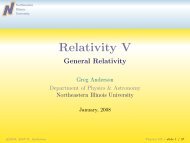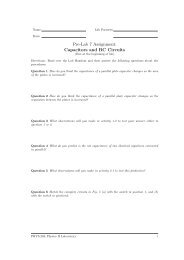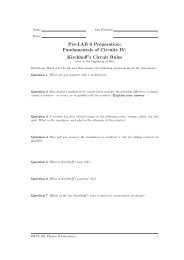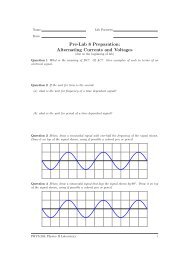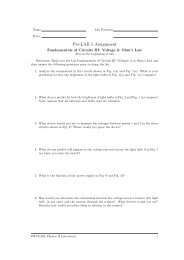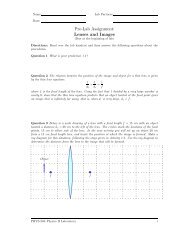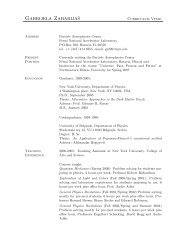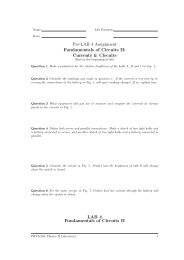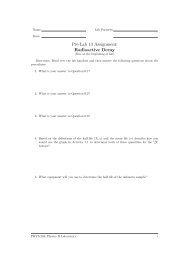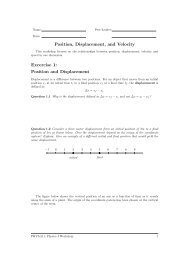Fundamentals of Circuits I: Current Models, Batteries & Bulbs
Fundamentals of Circuits I: Current Models, Batteries & Bulbs
Fundamentals of Circuits I: Current Models, Batteries & Bulbs
Create successful ePaper yourself
Turn your PDF publications into a flip-book with our unique Google optimized e-Paper software.
<strong>Fundamentals</strong> <strong>of</strong> <strong>Circuits</strong> I: <strong>Current</strong> <strong>Models</strong>, <strong>Batteries</strong> & <strong>Bulbs</strong> v 0.1<br />
Question 1.3 Do the charges generated by rubbing and by the power supply cause different<br />
effects If so, describe them. Do the charges generated in these two ways appear to<br />
be different<br />
The rate <strong>of</strong> flow <strong>of</strong> electric charge is more commonly called electric current. If charge ∆Q<br />
flows through a conductor in time ∆t, then the current can be expressed mathematically<br />
by the relationship<br />
I = ∆Q<br />
∆t .<br />
The SI unit <strong>of</strong> current is called the ampere (A). One ampere represents the flow <strong>of</strong> one<br />
coulomb <strong>of</strong> charge through a conductor in a time interval <strong>of</strong> one second. Another common<br />
unit <strong>of</strong> current is the milli-ampere (mA). (1 ampere = 1000 milli-amperes). It is common<br />
to refer to current as ”amps” or ”milliamps.”<br />
(a)<br />
+<br />
−<br />
(b)<br />
+<br />
−<br />
+<br />
−<br />
+<br />
−<br />
+<br />
+<br />
+<br />
+ +<br />
+ +<br />
+ +<br />
+<br />
v<br />
−<br />
−<br />
+<br />
+<br />
−<br />
−<br />
−<br />
− −<br />
−<br />
−<br />
−<br />
v<br />
−<br />
−<br />
+<br />
−<br />
+<br />
−<br />
Figure 2: Moving Charges<br />
Question 1.4 Consider Figs. 2(a) and 2(b). Do both figures show a current to the right<br />
Explain.<br />
Activity 1.2: Arrangements that Cause a Bulb to Light<br />
In this activity, you can begin to explore electric current by lighting a bulb with a battery. You<br />
will need the following:<br />
• flashlight bulb (#14)<br />
• flashlight battery (1.5 V D cell)<br />
PHYS-204: Physics II Laboratory 4




